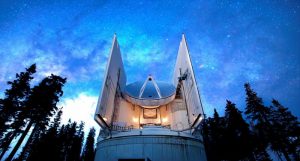
They are developing a new high performance radio astronomy spectrometer system where RFEL’s core forms a key component to improve sideband separation in their heterodyne receivers. To support the receiver’s wide signal bandwidth, the core utilizes parallelism to operate at a high input data rate of over 10 Giga samples per second.
“Radio astronomy is a perfect example of how our expertise can provide solutions that cannot be found elsewhere,” says Dr. Alex Kuhrt, RFEL’s CEO, “radio telescopes generate huge amounts of data that have to be processed without loss to extract signals. This requires specialist skills to create solutions that can handle this amount of data whilst retaining the mathematical precision. Our HyperSpeed FFT core is configured to match the demanding research needs of the ARO giving them the throughput and performance required.”
A fixed length, 8192-point, complex Fast Fourier Transform (FFT) is implemented using RFEL’s HyperSpeed architecture, with an internal complex data parallelism of 32, which will be clocked at 160 MHz. The input bit format is 12-bit signed twos complement and the input data is subject to a time-domain window function with user-programmable coefficients, allowing flexible selection of window types. The bit width will increase to 18 bits at the output of the core.
RFEL’s cores can support variable bit widths for all calculation stages throughout the data path and in the ARO core. The bit widths are manipulated to ensure mathematical precision is maintained allowing the core to meet the SFDR requirements. With ARO, RFEL is optimizing the rounding schemes and bit growths within the data paths. Convergent rounding will provide the lowest Signal to Noise Ratio (SNR) but with potential structure to the noise, whilst statistical rounding will result in slightly higher SNR, but with far less structure.
Robert Freund, principal engineer at ARO, concluded, “RFEL are real experts at providing cutting edge solutions that push the boundaries, enabling us to create more sensitive solutions. Standard off-the-shelf products just cannot deliver the performances that RFEL are able to achieve. The ARO operates two radio telescopes at millimeter wavelengths. Our facility receivers now cover the seven atmospheric windows from 4mm to 0.4mm and are used for both continuum and spectral line observations. The new wideband spectrometer will be a facility instrument that can be used with any receiver.”
The ARO is funded in part by an AST-URO grant from the National Science Foundation.
RFEL specialises in novel signal processing architectures and optimal VHDL coding that enables complex designs to utilise less FPGA resources without compromising overall system performance. In the case of ARO, the FPGA is a Xilinx Virtex 7 using Xilinx’s Vivado Design Tool.
Other solutions for Radio Astronomy that RFEL has created include cores for the Max Planck Institute for Radio Astronomy and a study contract with Oxford University for the Square Kilometer Array that will become the world’s largest radio telescope.
 Electronics Weekly Electronics Design & Components Tech News
Electronics Weekly Electronics Design & Components Tech News

